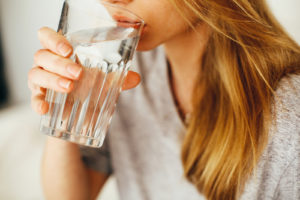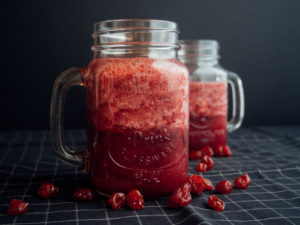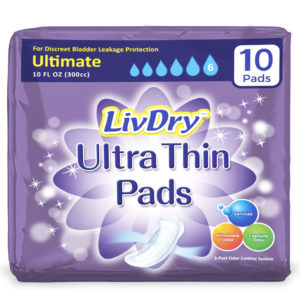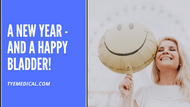8 Ways to Keep Your Bladder Healthy for the New Year
Written by tyemedical on Jan 13th 2020
Making New Year’s Resolutions? As you recommit to your health goals, remember the importance of your bladder health. Even if you battle incontinence, you can still adopt important habits to keep your bladder healthy and even improve symptoms. If you’re more interested in preventing incontinence problems entirely, then we’ve compiled tons of useful information for you as well – so read on!
For a healthier bladder this new year, you’ll need to take steps to prevent chronic bladder inflammation (or irritation), which not only aggravates incontinence symptoms but is also the one of the major causes of bladder cancer. Consider incorporating some of these helpful habits, because after all, a happy bladder means a happier you!
1. Go When You Need to Go
If you’re busy like most other people, you’re probably tempted to “hold it” whenever the urge strikes, but that’s not good for your bladder! When we resist the urge and hold urine in the bladder too long, over time it weakens the bladder walls and makes it more difficult to empty completely. This increases incontinence symptoms and can lead to more frequent urinary tract infections.
If your incontinence systems cause frequent urges, it’s okay to “hold it” for a reasonable amount of time if it’s part of bladder training– a topic we’ll address in a future article. But as a rule of thumb, it’s best to keep your bladder healthy and just go when you need to – busy or not.
As you respond to the call of nature, remember to relax and lean slightly forward. This allows your bladder to empty completely. When you’re tense, your bladder is usually constricted and fails to complete its mission, which increases the likelihood of infection and irritation. Relaxing and leaning forward allows your bladder to empty with greater ease and helps you avoid the negative effect of incomplete urination.

2. Drink Water Regularly and Space It Out
It’s not a good idea to combat urgency by drinking less. This will only concentrate your urine, irritate your bladder, and aggravate your frequency symptoms – or worse – you could develop a bladder infection.
If you want to keep your bladder healthy, consume the recommended amount of fluids but spread them out across the course of your day. Remember to avoid drinking more than 24 ounces at a time. Dumping too much liquid into your system at once tends to overwhelm your kidneys and throw off your body’s electrolyte balance, which can cause some serious health problems.
Try drinking 16 ounces of water with meals and 8 ounces between meals. According to the Mayo Clinic, if you’re not thirsty and your urine is pale yellow, you’re hydrated. Additionally, if you suffer from incontinence or an overactive bladder, try sticking to the recommended 64 ounces of water per day and keep a check on your urine. You might not need to drink more than the recommended amount to stay hydrated and ease your frequency symptoms.
Finally, it’s best to limit or avoid liquids two hours before your bedtime, especially if you battle nighttime incontinence or frequent urination.
3. Avoid Constipation with Fiber and Exercise
You might be surprised to learn that constipation negatively affects your bladder health. An overly full colon presses on the bladder which prevents proper bladder function. Also, straining during a bowel movement can damage the pelvic floor over time, triggering difficulty with bladder continence.
So what can you do? Keep your bladder healthy and maintain overall digestive health with a fiber-rich diet and exercise. In addition to drinking the recommended amount of water daily, try adding foods high in soluble fiber to your diet, foods like oats, bran, vegetables, and legumes (beans, lentils, peas).
If you struggle to add these foods to your diet or can’t consume them in adequate amounts, doctors frequently recommend supplements like Metamucil in powder or capsule form. They even make a sugar-free product, which is a great option if you have diabetes or are on a low-sugar diet.
Fiber isn’t your only friend in the fight against constipation. Try increasing your activity level by adding some walking or resistance training to your daily routine. Moderate activity helps your digestive system run more smoothly and can prevent constipation when combined with a healthy diet and proper fluid intake. You might find that winning the fight against constipation could ease bladder symptoms or prevent them from occurring in the first place.
4. Do Kegel Exercises
Your pelvic floor muscles help control urination and support the weight of your bladder, which means that the stronger they are, the more control you have over urination. Kegel exercises strengthen your pelvic floor muscles and help maintain a healthy bladder.
Whether you’re experiencing bladder problems or just want to prevent them, it’s a good idea to practice Kegels. Here’s how:
- Try from different positions daily: lying down, sitting, standing
- Squeeze your pelvic floor muscles like you’re trying to stop urination
- Hold for 3 seconds
- Relax the muscles and wait 3 seconds
- Repeat several times in a row
- Practice Kegel exercises 3-4 times daily
Kegels are easy to do and can be performed discreetly. They’re extremely beneficial if you want to keep your bladder healthy – and for many people, they’re a great way to improve incontinence symptoms.
5. Eat for Bladder Health
We’ve established that your bladder loves fiber-rich foods, but additionally, you’ll also need to avoid certain types of foods to keep your bladder healthy. In general, stay away from acidity, sugar, spice, alcohol and caffeine as they are known irritants. Be especially careful with alcohol and caffeine, including tea and chocolate. Most people don’t realize how much caffeine or alcohol they’re routinely consuming.
For a complete list of foods to avoid for bladder health, refer to this resource from Johns Hopkins.
Not all these foods and beverages will bother you, which means you’ll need to determine which ones your body can tolerate and which ones they can’t. If your sole interest is preventative, just remember to consume these foods and beverages in moderation, along with applying the other tips in this article.
If you’re suffering with incontinence or irritated bladder symptoms, consider using a bladder journal or symptom log to help determine the diet that’s right for you. Check out this free bladder journal resource from the National Association for Continence (NAFC). This will help you keep track of what food or beverage you consumed, when you ingested it, and what symptoms you experienced afterwards. You might find relief simply by eliminating or reducing certain foods and drinks.

6. Try Cranberry Supplements or Pumpkin Seed Extract
If you’ve struggled with recurrent UTI’s (urinary tract infections), then you’ve heard how cranberry juice or supplements can help prevent future infections. Well, the truth is more complicated than this.
Cranberries do contain an active ingredient that adheres to the lining of the bladder and helps prevent bacteria from sticking to the bladder walls, thereby preventing a bladder infection. However, many studies have proven that there’s not enough of this active ingredient in cranberry juice or cranberry supplements to prevent infections in the short term.
But if you want to keep your bladder healthy for the long haul, consider incorporating cranberry supplements into your diet. Purchase from trusted brands and take one tablet of concentrated cranberry extract (300 to 400 mg) twice daily, or 8 oz of pure unsweetened cranberry juice three times daily.
If you have an overactive bladder (OAB), consider adding pumpkin seed extract to your treatment plan. The evidence for its effectiveness is far from conclusive, but research is ongoing and reputable studies report a very positive impact on treating OAB when patients were given 500-1000 mg per day for 12 weeks.
7. Wear Looser Clothing
Bacteria flourish in a moist, warm environment. Tight-fitting clothes trap moisture and body heat, thereby accelerating bacteria growth. So, opt for clothing with a looser fit to keep the area surrounding your urethra cooler and drier.
Additionally, when clothing is tight around your abdomen and hips, additional pressure is placed on your internal organs, including your bladder, increasing your chances of a UTI and bladder pain.
Don’t forget to wear looser fitting underwear or incontinence underweartoo. Incontinence underwear should besnug, but certainlynot tight. For information about sizing for incontinence products, see question #8 on our FAQ page.
Most of us don’t like to wear a bigger size than we’re accustomed to wearing but increasing your clothing size can go a long way toward helping you keep your bladder healthy.
8. Take Breaks from Sitting
Prolonged sitting takes a toll on the bladder. People who sit for 5 or more hours per day are more likely to experience incomplete bladder emptying, urinary frequency or urgency, or having to urinate at night.
If you have a desk job or another reason to sit for prolonged periods of time, be sure to get up and move at least once each hour. Take a five-minute walk or complete a manual task that doesn’t involve sitting. The alternative? Spring for a standing desk that raises from a sitting to standing position, allowing you to switch between the two positions throughout the day. Standing desks fit atop your existing desk and adjust to your height. Both manual and electronic versions are available. Either way, reducing your sitting time will help keep your bladder healthy – and it’s kinder for your lower back.
 Leaking a Little? Leaking a Lot? We’ve Got You Covered!
Leaking a Little? Leaking a Lot? We’ve Got You Covered!
If you’re looking for comprehensive protection, our Protective Underwear and Premium Briefs offer 90 fl. Oz of protection!
Shop now to find the best product for you. Our helpful Associates are standing by to answer any and all questions you may have about our products!

